Biodegradable Green Composites: Effects of Potassium Permanganate (KMnO4) Treatment on Thermal, Mechanical, and Morphological Behavior of Butea Parviflora (BP) Fibers
Abstract
:1. Introduction
2. Methodologies
2.1. Fiber Extraction and Treatment
2.2. Physical Properties
2.2.1. Diameter and Aspect Ratios of BP
2.2.2. Linear Density of BP
2.2.3. Density of BP Using Pycnometer
| Fibers | Diameter | Aspect Ratio (L/D) | Linear Density (tex) | Density (g/cc) | References |
|---|---|---|---|---|---|
| Raw BP | 500 µm | 174.59 | 311.86 | 1.238 | Present work |
| KMnO4-treated BP | 488 µm | 305.00 | 459.00 | 1.409 | Present work |
| Ariel roots of banyan fiber | 0.09—0.14 µm | – | – | 1.23 | [29] |
| Cissus quadrangularis | 130 µm | – | – | 1.29 | [30] |
| Acacia leucophloea | 168.5 µm | – | – | 1.385 | [31] |
| Coccinia grandis | 543—621 µm | – | 130.90 | 1.517 | [32] |
3. Characterization Studies
3.1. XRD Studies
3.2. Single Fiber Tensile Test
3.3. Thermogravimetric Studies
3.4. Thermal Conductivity Studies
3.5. Morphological Studies Using SEM
3.6. FTIR Analysis
4. Results and Discussion
4.1. Chemical Composition
4.2. XRD Analysis
4.3. Tensile Testing
4.4. Tg-Dta Analysis
4.4.1. Differential Scanning Calorimetric Data
4.4.2. Activation Energy of BP
4.5. Thermal Conductivity
4.6. Morphological Studies Using SEM
4.7. FTIR Analysis
5. Conclusions
Author Contributions
Funding
Institutional Review Board Statement
Informed Consent Statement
Data Availability Statement
Acknowledgments
Conflicts of Interest
References
- Thyavihalli Girijappa, Y.G.; Mavinkere Rangappa, S.; Parameswaranpillai, J.; Siengchin, S. Natural Fibers as Sustainable and Renewable Resource for Development of Eco-Friendly Composites: A Comprehensive Review. Front. Mater. 2019, 6, 206. [Google Scholar] [CrossRef]
- Chakrawarthi, V.; Dharmar, B.; Avudaiappan, S.; Amran, M.; Flores, E.S.; Alam, M.A.; Fediuk, R.; Vatin, N.I.; Rashid, R.S.M. Destructive and Non-Destructive Testing of the Performance of Copper Slag Fiber-Reinforced Concrete. Materials 2022, 15, 4536. [Google Scholar] [CrossRef] [PubMed]
- Karimah, A.; Ridho, M.R.; Munawar, S.S.; Adi, D.S.; Ismadi; Damayanti, R.; Subiyanto, B.; Fatriasari, W.; Fudholi, A. A Review on Natural Fibers for Development of Eco-Friendly Bio-Composite: Characteristics, and Utilizations. J. Mater. Res. Technol. 2021, 13, 2442–2458. [Google Scholar] [CrossRef]
- Cruz, J.; Fangueiro, R. Surface Modification of Natural Fibers: A Review. Procedia Eng. 2016, 155, 285–288. [Google Scholar] [CrossRef]
- Birniwa, A.H.; Abdullahi, S.S.; Ali, M.; Mohammad, R.E.A.; Jagaba, A.H.; Amran, M.; Avudaiappan, S.; Maureira-Carsalade, N.; Flores, E.I.S. Recent Trends in Treatment and Fabrication of Plant-Based Fiber-Reinforced Epoxy Composite: A Review. J. Compos. Sci. 2023, 7, 120. [Google Scholar] [CrossRef]
- Batara, A.G.N.; Llanos, P.S.P.; de Yro, P.A.N.; Sanglay, G.C.D.; Magdaluyo, E.R. Surface Modification of Abaca Fibers by Permanganate and Alkaline Treatment via Factorial Design. AIP Conf. Proc. 2019, 2083, 030007. [Google Scholar]
- Mohd Izwan, S.; Sapuan, S.M.; Zuhri, M.Y.M.; Mohamed, A.R. Effects of Benzoyl Treatment on NaOH Treated Sugar Palm Fiber: Tensile, Thermal, and Morphological Properties. J. Mater. Res. Technol. 2020, 9, 5805–5814. [Google Scholar] [CrossRef]
- Saravanakumaar, A.; Senthilkumar, A.; Saravanakumar, S.S.; Sanjay, M.R.; Khan, A. Impact of Alkali Treatment on Physico-Chemical, Thermal, Structural and Tensile Properties of Carica Papaya Bark Fibers. Int. J. Polym. Anal. Charact. 2018, 23, 529–536. [Google Scholar] [CrossRef]
- Liu, H.; Pang, B.; Zhao, Y.; Lu, J.; Han, Y.; Wang, H. Comparative Study of Two Different Alkali-Mechanical Pretreatments of Corn Stover for Bioethanol Production. Fuel 2018, 221, 21–27. [Google Scholar] [CrossRef]
- Sathish, S.; Karthi, N.; Prabhu, L.; Gokulkumar, S.; Balaji, D.; Vigneshkumar, N.; Ajeem Farhan, T.S.; AkilKumar, A.; Dinesh, V.P. A Review of Natural Fiber Composites: Extraction Methods, Chemical Treatments and Applications. Mater. Today Proc. 2021, 45, 8017–8023. [Google Scholar] [CrossRef]
- Mohammed, L.; Ansari, M.N.M.; Pua, G.; Jawaid, M.; Islam, M.S. A Review on Natural Fiber Reinforced Polymer Composite and Its Applications. Int. J. Polym. Sci. 2015, 2015, 243947. [Google Scholar] [CrossRef]
- Jayanthi, V.; Avudaiappan, S.; Amran, M.; Arunachalam, K.P.; Qader, D.N.; Delgado, M.C.; Saavedra Flores, E.I.; Rashid, R.S.M. Innovative Use of Micronized Biomass Silica-GGBS as Agro-Industrial by-Products for the Production of a Sustainable High-Strength Geopolymer Concrete. Case Stud. Constr. Mater. 2023, 18, e01782. [Google Scholar] [CrossRef]
- Pickering, K.L.; Efendy, M.G.A.; Le, T.M. A Review of Recent Developments in Natural Fibre Composites and Their Mechanical Performance. Compos. Part A Appl. Sci. Manuf. 2016, 83, 98–112. [Google Scholar] [CrossRef]
- Sharma, K.A.; Deshwal, N. An Overview: On Phytochemical and Pharmacological Studies of Butea Monosperma. Int. J. Pharm. Tech. Res. 2011, 3, 864–871. [Google Scholar]
- Fageria, D.; Rao, D. A Review on Butea monosperma (Lam.) Kuntze: A Great Therapeutic Valuable Leguminous Plant. Int. J. Sci. Res. Publ. 2015, 5, 1–9. [Google Scholar]
- Awoyera, P.O.; Nworgu, T.A.; Shanmugam, B.; Prakash Arunachalam, K.; Mansouri, I.; Romero, L.M.B.; Hu, J.-W. Structural Retrofitting of Corroded Reinforced Concrete Beams Using Bamboo Fiber Laminate. Materials 2021, 14, 6711. [Google Scholar] [CrossRef]
- Sanjay, M.R.; Madhu, P.; Jawaid, M.; Senthamaraikannan, P.; Senthil, S.; Pradeep, S. Characterization and Properties of Natural Fiber Polymer Composites: A Comprehensive Review. J. Clean Prod. 2018, 172, 566–581. [Google Scholar] [CrossRef]
- Imoisili, P.E.; Jen, T.-C. Mechanical and Water Absorption Behaviour of Potassium Permanganate (KMnO4) Treated Plantain (Musa paradisiacal) Fibre/Epoxy Bio-Composites. J. Mater. Res. Technol. 2020, 9, 8705–8713. [Google Scholar] [CrossRef]
- Arsyad, M. Sodium Hydroxide and Potassium Permanganate Treatment on Mechanical Properties of Coconut Fibers. IOP Conf. Ser. Mater. Sci. Eng. 2019, 619, 012011. [Google Scholar] [CrossRef]
- Cakir, F.; Yildirim, P.; Kocak Dinc, B.; Balaban, M. Impact of High Aspect Ratios and Reinforcing Indexes on Mechanical Properties of Hybrid and Non-Hybrid Chopped Glass Fiber Reinforced Concrete. ACS Omega 2022, 7, 46798–46808. [Google Scholar] [CrossRef]
- Ma, H.; Li, Y.; Shen, Y.; Xie, L.; Wang, D. Effect of Linear Density and Yarn Structure on the Mechanical Properties of Ramie Fiber Yarn Reinforced Composites. Compos. Part A Appl. Sci. Manuf. 2016, 87, 98–108. [Google Scholar] [CrossRef]
- Truong, M.; Zhong, W.; Boyko, S.; Alcock, M. A Comparative Study on Natural Fibre Density Measurement. J. Text. Inst. 2009, 100, 525–529. [Google Scholar] [CrossRef]
- Danso, H.; Martinson, D.B.; Ali, M.; Williams, J. Effect of Fibre Aspect Ratio on Mechanical Properties of Soil Building Blocks. Constr. Build. Mater. 2015, 83, 314–319. [Google Scholar] [CrossRef]
- Pandita, S.D.; Yuan, X.; Manan, M.A.; Lau, C.H.; Subramanian, A.S.; Wei, J. Evaluation of Jute/Glass Hybrid Composite Sandwich: Water Resistance, Impact Properties and Life Cycle Assessment. J. Reinf. Plast. Compos. 2014, 33, 14–25. [Google Scholar] [CrossRef]
- Ouarhim, W.; Zari, N.; Bouhfid, R.; Qaiss, A.E.K. Mechanical Performance of Natural Fibers-Based Thermosetting Composites. In Mechanical and Physical Testing of Biocomposites, Fibre-Reinforced Composites and Hybrid Composites; Elsevier: Amsterdam, The Netherlands, 2018; pp. 43–60. [Google Scholar] [CrossRef]
- Imoisili, P.E.; Fadare, O.B.; Popoola, A.V.; Okoronkwo, A.E. Effect of Chemical Treatment on the Morphology and Mechanical Properties of Plantain (Musa paradisiaca) Fiber. IOSR J. Appl. Chem. 2017, 10, 70–73. [Google Scholar] [CrossRef]
- Rao, K.M.M.; Rao, K.M. Extraction and Tensile Properties of Natural Fibers: Vakka, Date and Bamboo. Compos. Struct. 2007, 77, 288–295. [Google Scholar] [CrossRef]
- Sathishkumar, T.P.; Navaneethakrishnan, P.; Shankar, S.; Rajasekar, R. Characterization of New Cellulose Sansevieria Ehrenbergii Fibers for Polymer Composites. Compos. Interfaces 2013, 20, 575–593. [Google Scholar] [CrossRef]
- Manimaran, P.; Senthamaraikannan, P.; Murugananthan, K.; Sanjay, M.R. Physicochemical Properties of New Cellulosic Fibers from Azadirachta Indica Plant. J. Nat. Fibers 2018, 15, 29–38. [Google Scholar] [CrossRef]
- Ganapathy, T.; Sathiskumar, R.; Senthamaraikannan, P.; Saravanakumar, S.S.; Khan, A. Characterization of Raw and Alkali Treated New Natural Cellulosic Fibres Extracted from the Aerial Roots of Banyan Tree. Int. J. Biol. Macromol. 2019, 138, 573–581. [Google Scholar] [CrossRef]
- Siva, R.; Mobithis, M.; Ravichandran, R.; Valarmathi, T.N.; Jeya Jeevahan, J.; Sangeetha, M. Characterization of Mechanical, Chemical Properties and Microstructure of Untreated and Treated Cissus Quadrangularis Fiber. Mater. Today Proc. 2021, 47, 4479–4483. [Google Scholar] [CrossRef]
- Manimaran, P.; Saravanakumar, S.S.; Mithun, N.K.; Senthamaraikannan, P. Physicochemical Properties of New Cellulosic Fibers from the Bark of Acacia arabica. Int. J. Polym. Anal. Charact. 2016, 21, 548–553. [Google Scholar] [CrossRef]
- Jebadurai, S.G.; Raj, R.E.; Sreenivasan, V.S.; Binoj, J.S. Comprehensive Characterization of Natural Cellulosic Fiber from Coccinia Grandis Stem. Carbohydr. Polym. 2019, 207, 675–683. [Google Scholar] [CrossRef]
- Segal, L.; Creely, J.J.; Martin, A.E.; Conrad, C.M. An Empirical Method for Estimating the Degree of Crystallinity of Native Cellulose Using the X-Ray Diffractometer. Text. Res. J. 1959, 29, 786–794. [Google Scholar] [CrossRef]
- Indran, S.; Raj, R.E. Characterization of New Natural Cellulosic Fiber from Cissus Quadrangularis Stem. Carbohydr. Polym. 2015, 117, 392–399. [Google Scholar] [CrossRef] [PubMed]
- Alam, M. Lee’s and Charlton’s Method for Investigation of Thermal Conductivity of Insulating Materials. IOSR J. Mech. Civ. Eng. 2012, 3, 53–60. [Google Scholar] [CrossRef]
- Maepa, C.E.; Jayaramudu, J.; Okonkwo, J.O.; Ray, S.S.; Sadiku, E.R.; Ramontja, J. Extraction and Characterization of Natural Cellulose Fibers from Maize Tassel. Int. J. Polym. Anal. Charact. 2015, 20, 99–109. [Google Scholar] [CrossRef]
- Fan, M.; Dai, D.; Huang, B.; Fan, M.; Dai, D.; Huang, B. Fourier Transform Infrared Spectroscopy for Natural Fibres. In Fourier Transform—Materials Analysis; IntechOpen: London, UK, 2012. [Google Scholar] [CrossRef]
- Shenoy Heckadka, S.; Nayak, S.Y.; Joe, T.; Zachariah, N.J.; Gupta, S.; Kumar, N.V.A.; Matuszewska, M. Comparative Evaluation of Chemical Treatment on the Physical and Mechanical Properties of Areca Frond, Banana, and Flax Fibers. J. Nat. Fibers 2022, 19, 1531–1543. [Google Scholar] [CrossRef]
- Mayandi, K.; Rajini, N.; Pitchipoo, P.; Jappes, J.T.W.; Rajulu, A.V. Extraction and Characterization of New Natural Lignocellulosic Fiber Cyperus pangorei. Int. J. Polym. Anal. Charact. 2016, 21, 175–183. [Google Scholar] [CrossRef]
- Hu, M.; Wang, C.; Lu, C.; Anuar, N.I.S.; Yousfani, S.H.S.; Jing, M.; Chen, Z.; Zakaria, S.; Zuo, H. Investigation on the Classified Extraction of the Bamboo Fiber and Its Properties. J. Nat. Fibers 2020, 17, 1798–1808. [Google Scholar] [CrossRef]
- Poletto, M.; Ornaghi Jnior, H.L.; Zattera, A.J. Thermal Decomposition of Natural Fibers: Kinetics and Degradation Mechanisms. In Reactions and Mechanisms in Thermal Analysis of Advanced Materials; Scrivener Publishing LLC.: Beverly, MA, USA, 2015; pp. 515–545. [Google Scholar] [CrossRef]
- Sreenivasan, V.S.; Somasundaram, S.; Ravindran, D.; Manikandan, V.; Narayanasamy, R. Microstructural, Physico-Chemical and Mechanical Characterisation of Sansevieria Cylindrica Fibres—An Exploratory Investigation. Mater. Des. 2011, 32, 453–461. [Google Scholar] [CrossRef]
- Baskaran, P.G.; Kathiresan, M.; Senthamaraikannan, P.; Saravanakumar, S.S. Characterization of New Natural Cellulosic Fiber from the Bark of Dichrostachys Cinerea. J. Nat. Fibers 2018, 15, 62–68. [Google Scholar] [CrossRef]
- Prakash, A.K.; Helena, H.J.; Oluwaseun Awoyera, P. Optimization of Mix Proportions for Novel Dry Stack Interlocking Concrete Blocks Using ANN. Adv. Civ. Eng. 2021, 2021, 9952781. [Google Scholar] [CrossRef]
- Cao, Y.; Sakamoto, S.; Goda, K. Effects of Heat and Alkali Treatments on Mechanical Properties of Kenaf Fibers. In Proceedings of the 16th International Conference on Composite Materials, Kyoyo, Japan, 8–13 July 2007; pp. 1–4. [Google Scholar]
- Hyness, N.R.J.; Vignesh, N.J.; Senthamaraikannan, P.; Saravanakumar, S.S.; Sanjay, M.R. Characterization of New Natural Cellulosic Fiber from Heteropogon contortus Plant. J. Nat. Fibers 2018, 15, 146–153. [Google Scholar] [CrossRef]
- Botta, L.; Fiore, V.; Scalici, T.; Valenza, A. New Polylactic Acid Composites Reinforced with Artichoke Fibers. Materials 2015, 8, 7770–7779. [Google Scholar] [CrossRef]
- Fiore, V.; Valenza, A.; Di Bella, G. Artichoke (Cynara cardunculus L.) Fibres as Potential Reinforcement of Composite Structures. Compos. Sci. Technol. 2011, 71, 1138–1144. [Google Scholar] [CrossRef]
- Porras, A.; Maranon, A.; Ashcroft, I.A. Characterization of a Novel Natural Cellulose Fabric from Manicaria Saccifera Palm as Possible Reinforcement of Composite Materials. Compos. B Eng. 2015, 74, 66–73. [Google Scholar] [CrossRef]
- Reddy, N.; Yang, Y. Structure and Properties of High Quality Natural Cellulose Fibers from Cornstalks. Polymer 2005, 46, 5494–5500. [Google Scholar] [CrossRef]
- Djafari Petroudy, S.R. Physical and Mechanical Properties of Natural Fibers. In Advanced High Strength Natural Fibre Composites in Construction; Elsevier: Amsterdam, The Netherlands, 2017; pp. 59–83. [Google Scholar]
- Shahinur, S.; Hasan, M.; Ahsan, Q.; Haider, J. Effect of Chemical Treatment on Thermal Properties of Jute Fiber Used in Polymer Composites. J. Compos. Sci. 2020, 4, 132. [Google Scholar] [CrossRef]
- Bodur, M.S.; Bakkal, M.; Sonmez, H.E. The Effects of Different Chemical Treatment Methods on the Mechanical and Thermal Properties of Textile Fiber Reinforced Polymer Composites. J. Compos. Mater. 2016, 50, 3817–3830. [Google Scholar] [CrossRef]
- Brebu, M.; Vasile, C. Thermal Degradation of Lignin-A Review. Cellul. Chem. Technol 2010, 44, 353–363. [Google Scholar]
- Oza, S.; Ning, H.; Ferguson, I.; Lu, N. Effect of Surface Treatment on Thermal Stability of the Hemp-PLA Composites: Correlation of Activation Energy with Thermal Degradation. Compos. B Eng. 2014, 67, 227–232. [Google Scholar] [CrossRef]
- Senthamaraikannan, P.; Kathiresan, M. Characterization of Raw and Alkali Treated New Natural Cellulosic Fiber from Coccinia grandis L. Carbohydr. Polym. 2018, 186, 332–343. [Google Scholar] [CrossRef] [PubMed]
- Balaji, A.N.; Nagarajan, K.J. Characterization of Alkali Treated and Untreated New Cellulosic Fiber from Saharan Aloe Vera Cactus Leaves. Carbohydr. Polym. 2017, 174, 200–208. [Google Scholar] [CrossRef]
- Zhao, R.; Guo, H.; Yi, X.; Gao, W.; Zhang, H.; Bai, Y.; Wang, T. Research on Thermal Insulation Properties of Plant Fiber Composite Building Material: A Review. Int. J. Thermophys. 2020, 41, 87. [Google Scholar] [CrossRef]
- Sandesh, A.; Chetan, G.; Sunil, K.C.; Narayana, Y. Determination of Thermal Conductivity of Areca Husk Fiber by Lee’s Disc Method. Res. J. Chem. Environ. 2020, 24, 17–21. [Google Scholar]
- Zhou, X.; Zheng, F.; Li, H.; Lu, C. An Environment-Friendly Thermal Insulation Material from Cotton Stalk Fibers. Energy Build. 2010, 42, 1070–1074. [Google Scholar] [CrossRef]
- Gonçalves, A.P.B.; De Miranda, C.S.; Guimarães, D.H.; De Oliveira, J.C.; Cruz, A.M.F.; Da Silva, F.L.B.M.; Luporini, S.; José, N.M. Physicochemical, Mechanical and Morphologic Characterization of Purple Banana Fibers. Mater. Res. 2015, 18, 205–209. [Google Scholar] [CrossRef]
- Kavitha, S.A.; Priya, R.K.; Arunachalam, K.P.; Avudaiappan, S.; Maureira-Carsalade, N.; Roco-Videla, Á. Investigation on Properties of Raw and Alkali Treated Novel Cellulosic Root Fibres of Zea Mays for Polymeric Composites. Polymers 2023, 15, 1802. [Google Scholar] [CrossRef]
- Khan, A.; Vijay, R.; Singaravelu, D.L.; Sanjay, M.R.; Siengchin, S.; Jawaid, M.; Alamry, K.A.; Asiri, A.M. Extraction and Characterization of Natural Fibers from Citrullus Lanatus Climber. J. Nat. Fibers 2022, 19, 621–629. [Google Scholar] [CrossRef]
- Amutha, K.; Sudha, A.; Saravanan, D. Characterization of Natural Fibers Extracted from Banana Inflorescence Bracts. J. Nat. Fibers 2022, 19, 872–881. [Google Scholar] [CrossRef]
- Binoj, J.S.; Edwin Raj, R.; Sreenivasan, V.S.; Rexin Thusnavis, G. Morphological, Physical, Mechanical, Chemical and Thermal Characterization of Sustainable Indian Areca Fruit Husk Fibers (Areca catechu L.) as Potential Alternate for Hazardous Synthetic Fibers. J. Bionic. Eng. 2016, 13, 156–165. [Google Scholar] [CrossRef]
- Subramanian, K.; Senthil Kumar, P.; Jeyapal, P.; Venkatesh, N. Characterization of Ligno-Cellulosic Seed Fibre from Wrightia Tinctoria Plant for Textile Applications—An Exploratory Investigation. Eur. Polym. J. 2005, 41, 853–861. [Google Scholar] [CrossRef]
- Maache, M.; Bezazi, A.; Amroune, S.; Scarpa, F.; Dufresne, A. Characterization of a Novel Natural Cellulosic Fiber from Juncus effusus L. Carbohydr. Polym. 2017, 171, 163–172. [Google Scholar] [CrossRef] [PubMed]
- Subramanian, S.G.; Rajkumar, R.; Ramkumar, T. Characterization of Natural Cellulosic Fiber from Cereus hildmannianus. J. Nat. Fibers 2021, 18, 343–354. [Google Scholar] [CrossRef]
- Seki, Y.; Sarikanat, M.; Sever, K.; Durmuşkahya, C. Extraction and Properties of Ferula communis (Chakshir) Fibers as Novel Reinforcement for Composites Materials. Compos. B Eng. 2013, 44, 517–523. [Google Scholar] [CrossRef]
- Ranganagowda, R.P.G.; Kamath, S.S.; Bennehalli, B.; Muddanna, A.; Sampathkumar, D.; Chikkol Venkateshappa, S. Spectral Studies on Chemically Modified Single Areca Fibre. Mater. Today Proc. 2018, 5, 28018–28025. [Google Scholar] [CrossRef]
- Masłowski, M.; Miedzianowska, J.; Strzelec, K. Natural Rubber Composites Filled with Cereals Straw Modified with Acetic and Maleic Anhydride: Preparation and Properties. J. Polym. Env. 2018, 26, 4141–4157. [Google Scholar] [CrossRef]
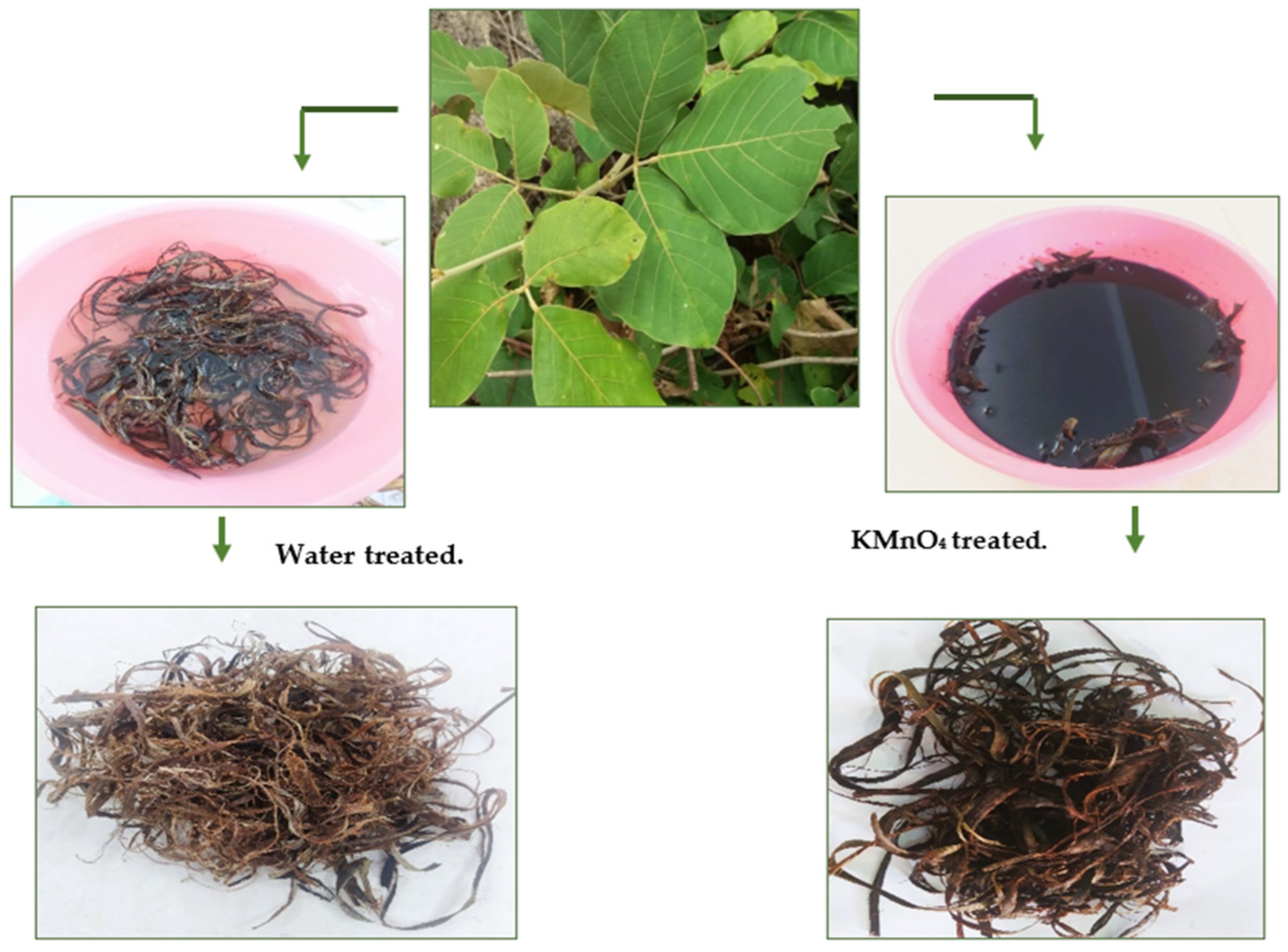
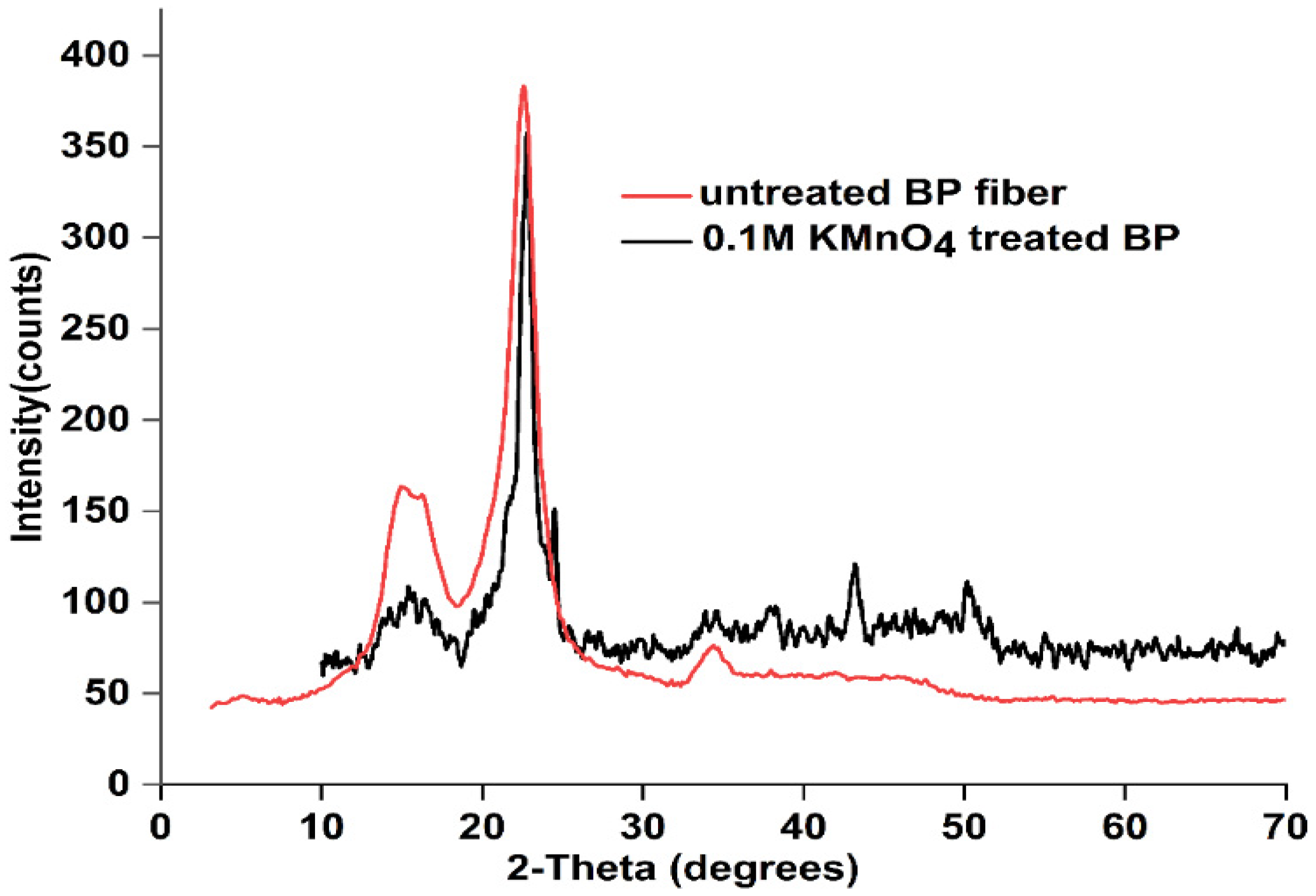
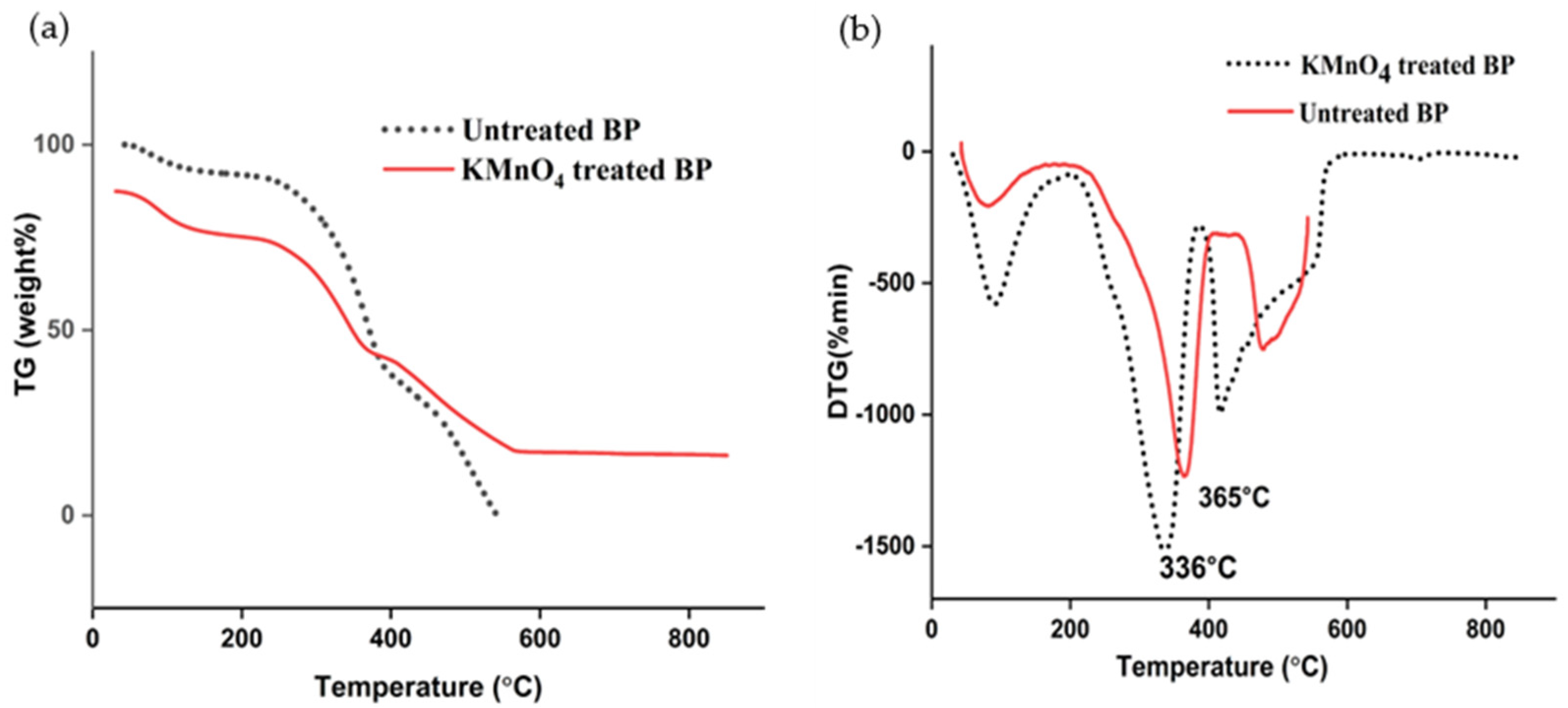

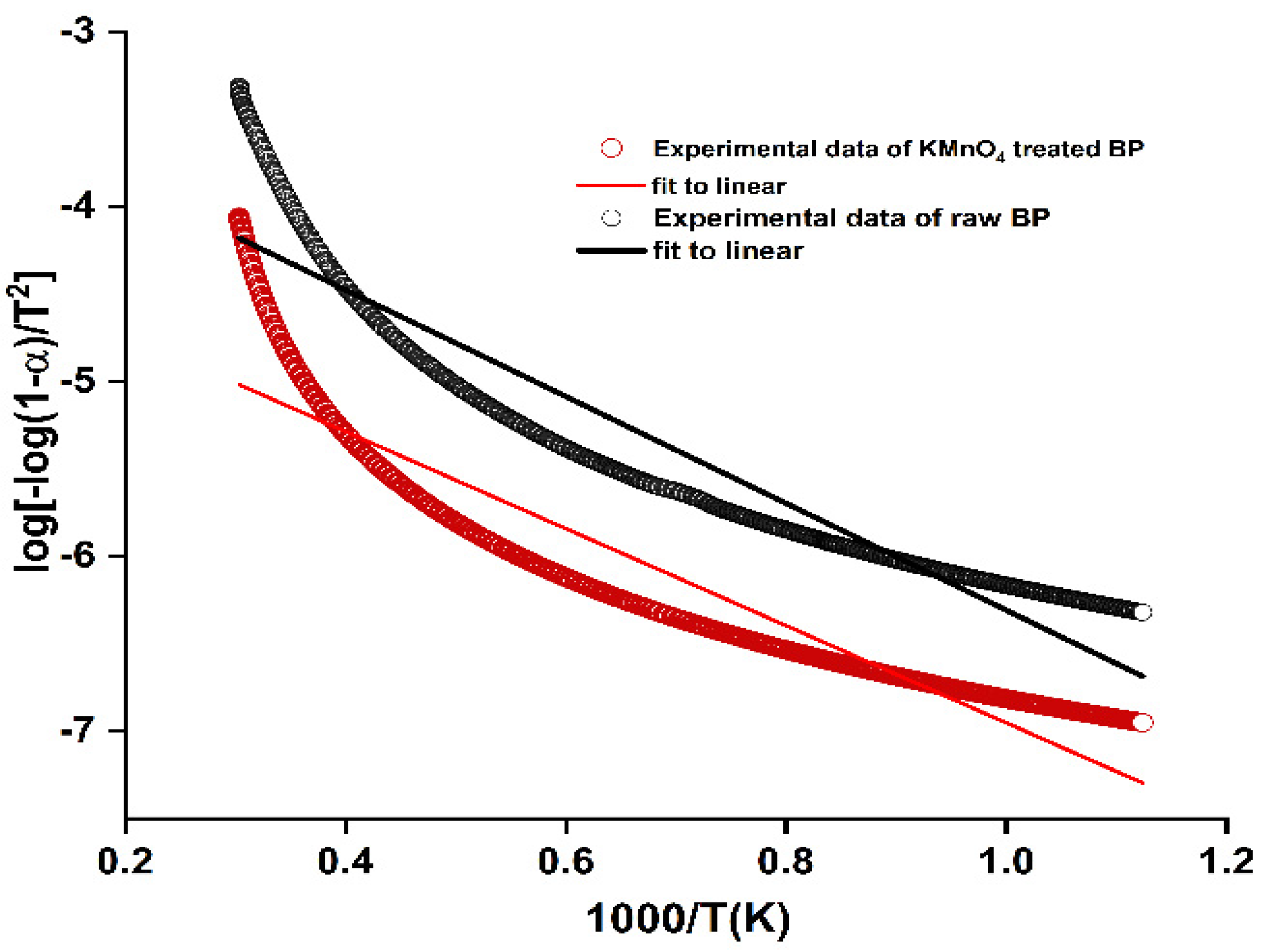
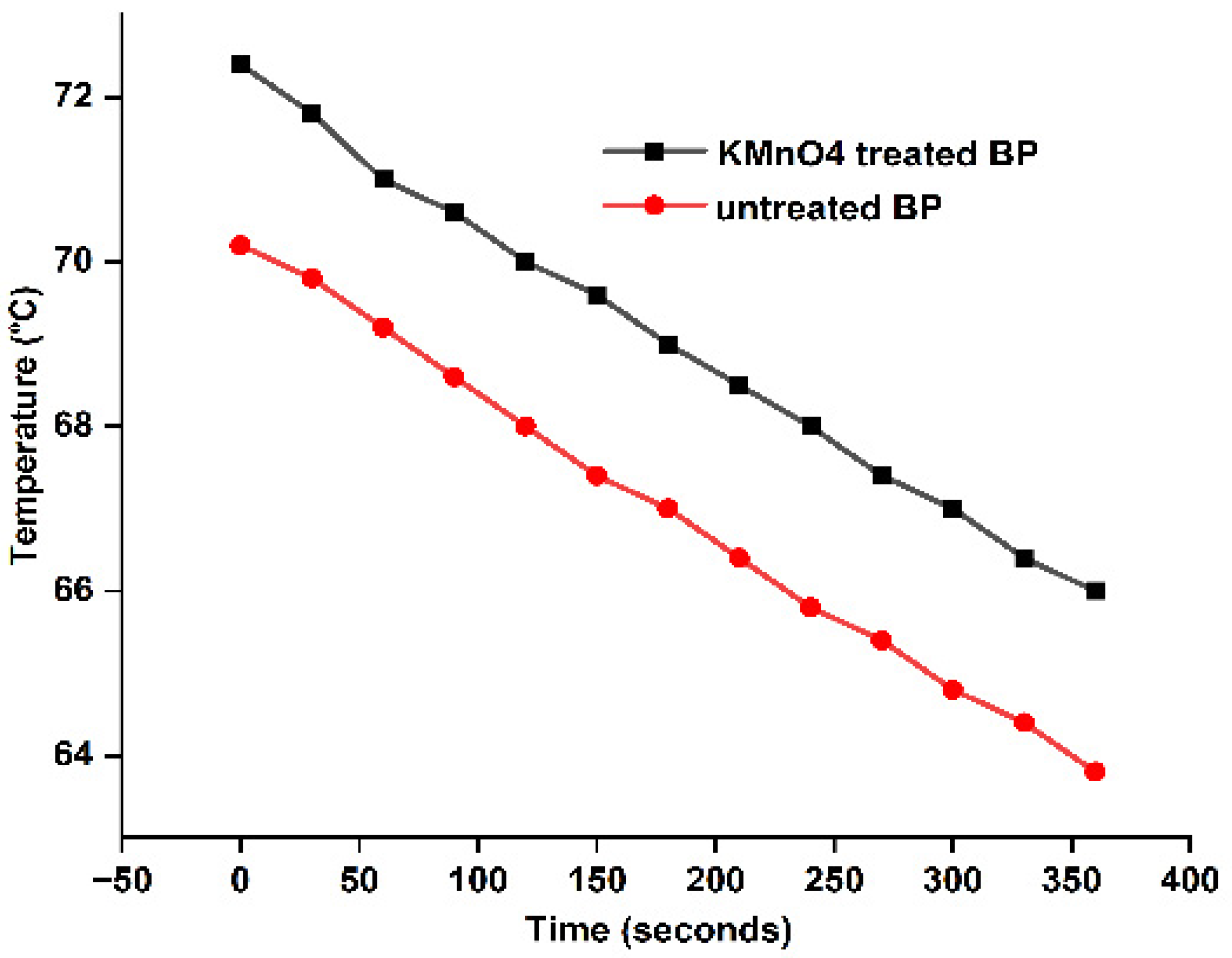

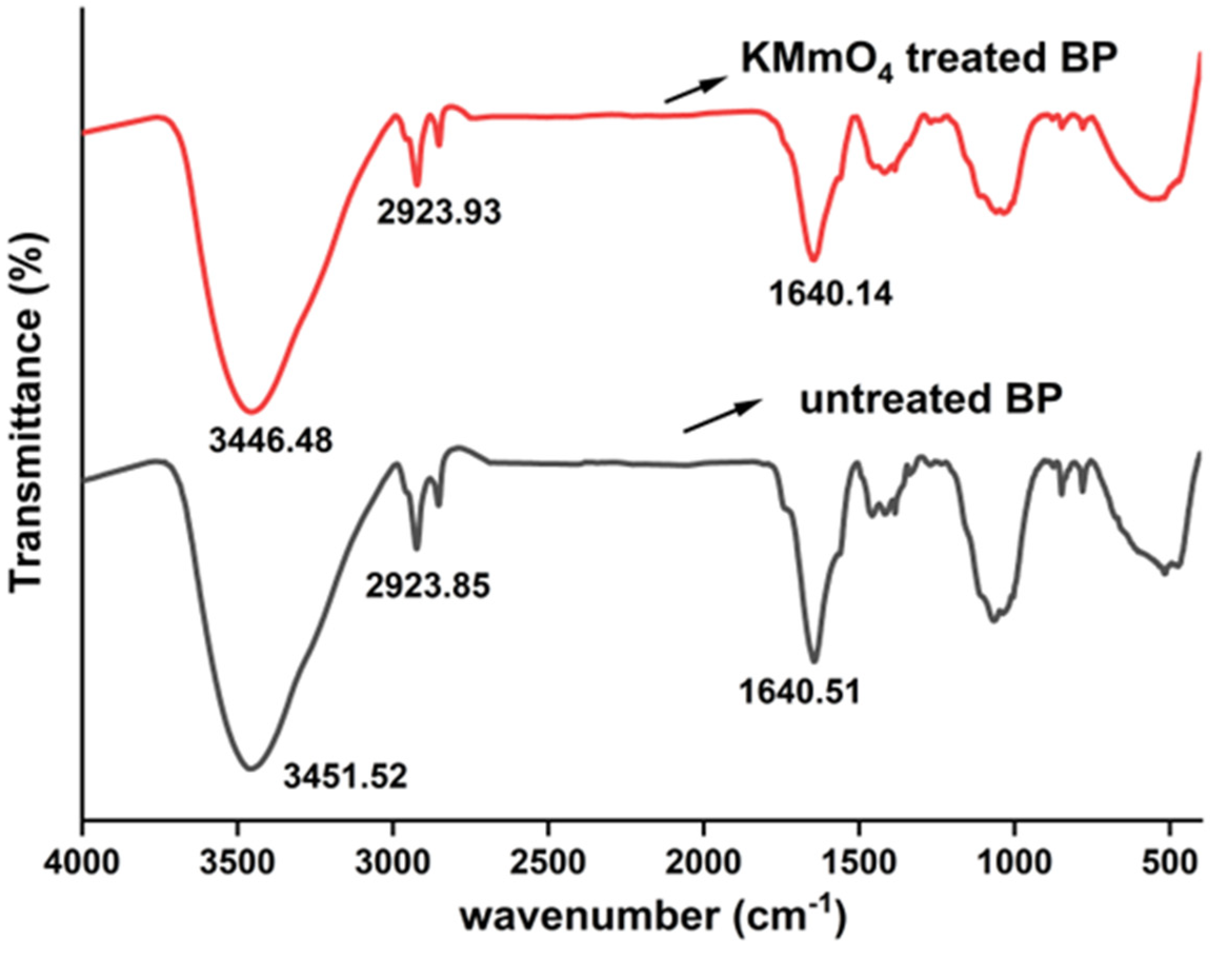
| Fibers | Chemical Composition (wt %) | Crystalline Properties | |||||
|---|---|---|---|---|---|---|---|
| Cellulose | Hemicellulose | Lignin | Moisture | Wax | Crystallinity Index | Crystallite Size | |
| Raw BP | 58.5 | 40.13 | 18.09 | 11.63 | 0.31 | 83.63 | 7.5 nm |
| KMnO4-treated BP | 59.4 | 21.8 | 13.5 | 13.53 | 0.23 | 83.47 | 6.4 nm |
| flax | 64.10 | 16.70 | 2.0 | 10 | 1.5 | – | – |
| Sansevieria cylindrica | 79.7 | 10.13 | 3.8 | – | 0.09 | 60.0 | 86 |
| Cyperus pangorei | 68.5 | – | 17.8 | 9.19 | 0.17 | 41.0 | – |
| Ariel roots of banyan | 67.63 | 13.46 | 15.62 | 10.21 | 0.81 | 72.47 | 6.28 |
| Fibers | Tensile Strength (MPa) | Tensile Modulus (GPa) | Elongation at Break (%) | Reference |
|---|---|---|---|---|
| Raw BP | 92.64 | 2.16 | 7.2 | Present work |
| KMnO4-treated BP | 198.12 | 4.40 | 4.5 | Present work |
| Cissus quadrangularis | 200.39 | 4.89 | 3.57–8.37 | [31] |
| Manicaria saccifera | 72.09 | 2.20 | – | [50] |
| Ariel roots of banyan fiber | 19.37 | 1.8 | 1.8 ± 0.40 | [30] |
| Cyperus pangorei | 196 | 11.6 | 1.69 | [40] |
| Samples | Max Degradation Temperature (°C) | Activation Energy (Ea) | Thermal Conductivity (K) |
|---|---|---|---|
| Untreated BP | 365 | 73.15 KJ/mol | 0.029 W/mk |
| KMnO4-treated BP | 336 | 62.80−63.46 KJ/mol | 0.032 W/mk |
| Wavenumber (cm) −1 | Vibrational Band Assignments | |
|---|---|---|
| Raw BP | 0.1 M KMnO4 Treated BP | |
| 3451.52 | 3446.48 | H2 bonded O–H group of cellulose |
| 2923.85 | 2923.93 | C–H2 stretching of cellulose |
| 2853.34 | 2852.31 | C–H stretching of hemicelluloses |
| 1640.51 | 1640.14 | C=O stretching of acetyl group in hemicellulose |
| – | 1423 | C–H2 symmetric bending in cellulose |
| 1384.21 | – | Asymmetric COC stretching of lignin |
| – | 1269.41 | C-O stretching of acetyl group in lignin and hemicelluloses |
| 1068.81 | – | C-O stretching variations of polysaccharides |
| 1036.97 | 1034.82 | C–O stretching |
| 873.40 | 877.24 | β-glycosidic linkage in monosaccharides |
| 780.78 | 780.02 | CO stretching |
| – | 646.78 | CS stretching |
| 517.10 | – | Out of plane bending of OH |
Disclaimer/Publisher’s Note: The statements, opinions and data contained in all publications are solely those of the individual author(s) and contributor(s) and not of MDPI and/or the editor(s). MDPI and/or the editor(s) disclaim responsibility for any injury to people or property resulting from any ideas, methods, instructions or products referred to in the content. |
© 2023 by the authors. Licensee MDPI, Basel, Switzerland. This article is an open access article distributed under the terms and conditions of the Creative Commons Attribution (CC BY) license (https://creativecommons.org/licenses/by/4.0/).
Share and Cite
Abisha, M.; Priya, R.K.; Arunachalam, K.P.; Avudaiappan, S.; Saavedra Flores, E.I.; Parra, P.F. Biodegradable Green Composites: Effects of Potassium Permanganate (KMnO4) Treatment on Thermal, Mechanical, and Morphological Behavior of Butea Parviflora (BP) Fibers. Polymers 2023, 15, 2197. https://doi.org/10.3390/polym15092197
Abisha M, Priya RK, Arunachalam KP, Avudaiappan S, Saavedra Flores EI, Parra PF. Biodegradable Green Composites: Effects of Potassium Permanganate (KMnO4) Treatment on Thermal, Mechanical, and Morphological Behavior of Butea Parviflora (BP) Fibers. Polymers. 2023; 15(9):2197. https://doi.org/10.3390/polym15092197
Chicago/Turabian StyleAbisha, M., R. Krishna Priya, Krishna Prakash Arunachalam, Siva Avudaiappan, Erick I. Saavedra Flores, and Pablo Fernando Parra. 2023. "Biodegradable Green Composites: Effects of Potassium Permanganate (KMnO4) Treatment on Thermal, Mechanical, and Morphological Behavior of Butea Parviflora (BP) Fibers" Polymers 15, no. 9: 2197. https://doi.org/10.3390/polym15092197
APA StyleAbisha, M., Priya, R. K., Arunachalam, K. P., Avudaiappan, S., Saavedra Flores, E. I., & Parra, P. F. (2023). Biodegradable Green Composites: Effects of Potassium Permanganate (KMnO4) Treatment on Thermal, Mechanical, and Morphological Behavior of Butea Parviflora (BP) Fibers. Polymers, 15(9), 2197. https://doi.org/10.3390/polym15092197








